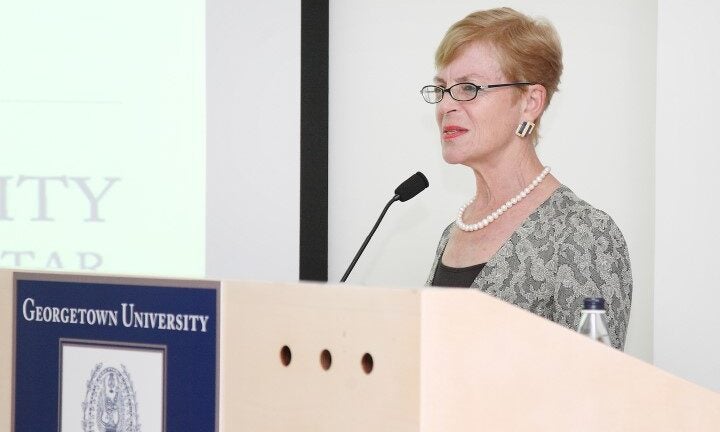Dialogue Series, Race & Society, Regional Studies
Miriam Cooke Lectures on Heritage Projects in the GCC

Miriam Cooke, Professor of Arab Cultures at Duke University and Fall 2010 Scholar-in-Residence at the Museum of Islamic Art in Doha, delivered the November CIRS Monthly Dialogue on the topic of “The Tribal Modern: The Past as Future.”
In examining a variety of “heritage projects” in Qatar and the Gulf states, Cooke acknowledged the literature of Ibn Khaldun and his binary scheme of distinction between the desert nomadic, otherwise known as “badawa,” and the sedentary urban, known as “hadara” in many current Arab cultures. The “badawa” symbolizes nomadism, loyalty, and tribalism and “hadara,” on the other hand, is symbolic of modernity, urbanization, and individualism. Both concepts are used to distinguish the “self” from the “other” in Arab societies. When used to describe the self, Cooke argued, either word has positive connotations, but when used to describe the other, it is often tinged with criticism of the other’s way of life, be it modern or traditional. “These two terms,” she argued, “are current in Gulf vocabulary, and are deployed to designate cultural differences.”
Cooke argued that both concepts are constitutive of the heterogeneity inherent in Arab cultures and so it is important “to bring the two cultures together in such a way that they complement and enhance each other and strengthen the modernization efforts underway” in many Gulf states. These largely oppositional tropes between the traditional and the modern, Cooke noted, are negotiated and played out in the current “heritage projects.” Areas such as Suq Waqif in Doha are primary examples of how the old and modern aspects of Qatari culture are intertwined in architectural design of public spaces.
In order to further explore these underlying cultural imaginings, Cooke contacted Mohamed Ali, the designer and architect of the restoration of Suq Waqif. She noted that “it was through him that I began to see that ‘badawa’ and ‘hadara’ are being braided together.” In order to reconstruct the old market area, the architect, “finding very little reliable historical documentation, interviewed old people for fragments and figments of their imagination.”
Suq Waqif differs greatly from the highly modernized cityscape of the downtown financial district of West Bay, and, so, Cooke argued, the architecture of Doha has become an assimilation of the old and new and of the ‘badawa’ and ‘hadara.’ She noted that “where the skyscrapers compete for the prize in cutting-edge Western technology and aesthetics, and the Museum of Islamic Art was designed to blend the architectural variety of Islamdom into a single seamless whole, Suq Waqif was to be made of local materials and to embody the spirit of the Gulf.” Indeed, Cooke argued, “Suq Waqif, for me, is the emblematic working out of the tribal modern.”
This historical reference to cultural and tribal purity, or asala, is a symptom of globalization and modernity, argued Cooke, as nations attempt to rebuild cultural identities after years of colonial struggle. She noted that “the Arab world states, whose citizens are the first generation to grow up with a national, rather than a regional, identity, are involved in a future articulation of a largely unrecorded past that lies buried under the surface of identical newly global cities.” In this sense, many of these renovation projects are state-sponsored and are in service to the idea of the patriotic.
Cooke confirmed that “heritage projects erase pre-national ethnoscapes and deterritorialize lifestyles. They provide the tabula rasa on which the mass migrations of workers can be projected as new. Colonialism disappears behind the façade of ethnic purity and isolation. The heritage that is being revived glosses over four centuries of struggle between the Portuguese, the Ottomans, and the British for control of the valuable waterways that link the Fertile Crescent with the Indian Ocean.”
Concluding the lecture, Cooke argued that, in any of these heritage projects, whether architectural, sartorial, or linguistic, it is not an actual tribe that is being revived to serve as the backdrop for the embodiment of cultural purity, but the “idea” of a tribe. In fact, she said, “it doesn’t matter that Suq Waqif is a simulacrum; it produces the ideal, the idea, and the feel of the authentic (the aseel).”
Article by Suzi Mirgani, CIRS Publications Coordinator